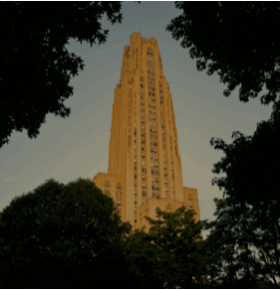
Subscribe to Pittwire Today
Get the most interesting and important stories from the University of Pittsburgh.At an offsite storage facility for the Carnegie Museum of Natural History, you can open any cabinet and find objects from around the world: intricate samurai swords, massive pottery, even dressed-up fleas.
Some afternoons you can also find a group of Pitt undergraduates with a handheld 3D scanner painstakingly digitizing the collections one piece at a time. They’re not there for course credit or even official club activities — just a desire to learn cutting-edge technology for their own future careers.
“I was doing the scanning at first, and then I transitioned and now they do all the scanning,” said Pitt staff member Josh Cannon, a scholar-mentor in the University Honors College. “Now they’re better than I am.”
With a background in archaeology and 3D scanning, Cannon (UHC, A&S ’10) kicked off the collaboration by bringing the idea to the museum. Funding for laptops and Artech scanners (which don’t come cheap, at about $50,000 for the pair) came from Carnegie Discoverers, a member group of the museum. And Cannon rounded up a group of motivated undergraduates, ranging from a first year to seniors. All five were eager to learn to use the technology for their own work in museum studies, anthropology and paleontology.
Even in the early stages of the collaboration, the group’s scans are finding their way into museum exhibits. An upcoming display case titled “From Egypt to Pittsburgh,” assembled by Carnegie Museum of Natural History Assistant Curator Lisa Haney, will feature stories of how objects in the museum’s care made their way across the Atlantic, as well as screens displaying scans of the objects created by students.
“Having 3D scans allows you to see so much more of the piece, because you can zoom in on things and see different features,” Haney said. The display will also feature a second Pitt collaboration: “The content will also be offered in Egyptian Arabic, and we’ll be working with the Pitt Arabic Club on those translations,” Haney added.
Having finished their work for that exhibit, the group now has a broader mandate: keep scanning challenging objects, and eventually be available for any researchers at the museum who want a new way of looking at an item in their collection.




While much can be learned about an object simply by looking at it closely, there are some details that only scanning can bring out.
“Sometimes you can see fingerprints and things that you wouldn’t be able to see with the naked eye, so you can kind of see what this person was doing all those years ago,” said first-year student Derek Wessel. And along with those fine details, scans can help researchers see the bigger picture of what they’re looking at.
“I really like the reconstructive aspect of it, where we can take things that are broken, scan parts of them and, in the virtual world, put them back together,” Wessel said.
Scans also allow researchers to share information about fragile objects or objects that can’t be transported for other reasons.
It’s not just researchers who benefit from scanning museum collections. 3D scans can provide the museum-going public with a way of looking at the objects that wouldn’t be available in a static exhibit, and it also opens the possibility of printing replicas for visitors to handle (or piece together, in the case of pottery fragments).

Making the scans themselves, though, isn’t easy: It’s a skill that takes a deft touch and a fair amount of determination.
When the team was first learning the technology, each student brought in an object to scan. “I brought in a little ceramic pig tchotchke,” said anthropology and history of art and architecture senior Brianna Stellini. She figured it’d be easy to scan because of its size and texture. “It ended up having the face on the side and it had four eyes and four ears. I created a nightmare.”
To do it right, you have to make multiple precise passes over an object with the scanner, combine different layers in the computer program and then meticulously clean up the resulting data to create the final image.
With lots of practice, Stellini and her fellow students have come a long way since the pig debacle. And for each of them, this painstaking work is an exciting entryway into the world of museums. “I’m trying to get into the field of museum collection management. So this is exactly what I want to be doing,” she said.
The rest of the team includes students Charlie Taylor, Helena Hzyiak and Emily Wiley. As each of the five develop their skills and their academic interests, they plan to work with other museum sections, including paleontology and mammals.
“What we really want to have happen in the near future is for students to develop relationships with research sections at the museum and then maybe start using the data they’ve scanned for their own research,” Cannon said. “This work with the anthropology section is just the beginning.”
— Patrick Monahan


